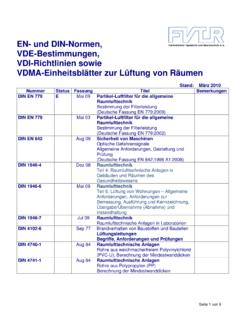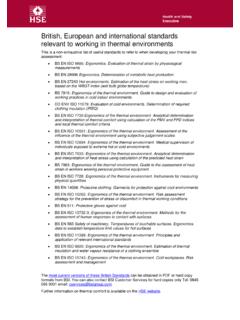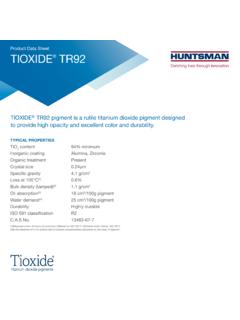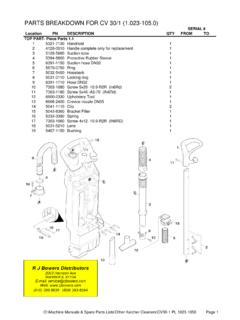Transcription of Introduction to thermal comfort standards - UTCI
1 19 Introduction to thermal comfort standardsK C ParsonsLoughborough University, UKAbstractThe aim of this paper is to describe existing ISO standards and current activityconcerned with thermal comfort . It describes how an ISO standard is produced froma new work item proposal (NP) to publication as an international standard (ISO). Aframework is provided for the assessment of ISO standards and their should be valid, reliable, useable, and with sufficient scope for practicalapplication. The existing thermal comfort standard (ISO 7730 ) is considered in termsof these criteria as well as ISO 8996 (metabolic rate) and ISO 9920 (clothing). Theconsequences of inaccuracy in estimation of metabolic rate and clothing insulationshow that reasonable estimates can provide a range of thermal sensation work of ISO/TC 159 SC5, Ergonomics of the physical environment , ispresented in Appendix 1. Descriptions of ISO 7726 (instruments), ISO 10551(subjective measures), ISO TS 13732 Part 2 (contact with surfaces at moderatetemperature), ISO 14505 (vehicles), and ISO 14515 (people with specialrequirements) are described in Appendix : standards , thermal comfortIntroductionThere are a number of national organizations whose standards have internationalinfluence and some make a contribution to the creation of knowledge of thermalcomfort and the application of that knowledge.
2 For a standard to be trulyinternational however requires a co-ordination of countries and a process of commonconsent. The International standards Organization (ISO) was set up in 1947 and hasover 130 member countries. Its principles of a single representative organizationfrom each country and a democratic system of voting support the notion of ademocratic process of globalization and a fairly operating world market in a worldeconomy. It is interesting that one of the major issues concerning thermal comfort isthe apparent conflict between a so called western approach, which attempts to seal a building and control the internal environment to constant levels of air temperatureappropriate to western behaviour and clothing, and an adaptive approach wherepeople can adapt to a wider range of conditions that complement their culture and inhot (or even cold) climates are less energy demanding. The issue is more complex,however it demonstrates the advantage of international consensus over national trendsand interests.
3 That is, an international organization with democratic processes willallow a broad international perspective to be aim of this paper is to provide an Introduction to ISO standards concerned withthermal comfort . The standards are described in the context of the ISO system forstandards production, existing ISO standards concerned with people in thermalenvironments, current thinking about future standards , and decisions that need to bemade to bring thermal comfort standards into the 21st century. The paper is anintroductory paper to the Conference and, in particular, provides background to theproposed revision of ISO 7730 , which is described by Dr Bjarne Olesen later in thisconference is an ISO standard produced?ISO standards are produced by experts from participating countries (P - members)according to agreed rules and a system of voting. There is a six-stage process fromthe initial idea for a standard to its final publication.
4 This is shown in Table 1: Six-stage process to the production of an International Standard (ISO)StageProcessDocument1 New work item proposal (TC, SC, WG, national,regional, organization, individual)New Proposal (NP)(Enquiry/Voting)2 Building expert consensus (WG)Working Document(WD)3 Consensus building across countries (TC, SC, WG)Committee Draft(CD)(Enquiry/Voting)4 Integration of comments and preparation of DraftInternational Standard (WG)Draft InternationalStandard (DIS)(Enquiry/Voting)5 Integration of editorial comments and preparation ofFinal Draft International Standard (WG)Final DraftInternationalStandard (FDIS)(Enquiry and Yes/Novote)6 Preparation of International Standard (Secretariat)InternationalStandard (ISO)Key:WG = Working Group ISO/TC 159 SC5 WG1 Ergonomics of the ThermalEnvironmentConvener: Dr Bjarne Olesen, DenmarkSC = Sub-Committee ISO/TC 159 SC5 Ergonomics of the Physical EnvironmentChairman: Professor Ken Parsons, UK; Secretariat BSI: Dr Sina TalalTC = Technical Committee ISO/TC 159 ErgonomicsChairman: Wolfgang Schultetus, Germany; Secretariat DIN: Norbert BreutmannA thermal comfort standard is proposed (by a working group, committee or other) andsupported by a document that explains the requirement, the rationale and the scope ofthe proposed standard.
5 The sub-committee (ISO/TC 159 SC5) then considers theproposal and submits it for international voting. On acceptance and an indication thatsufficient (5 ) member countries will participate in the work, the sub-committeeallocates the work to a working group (ISO/TC 159 SC5 WG1). The working groupidentifies a project leader who develops working documents with advice andcomments from the international experts under the guidance and co-ordination of theconvener. A proposal to revise a standard would also be considered as a newproposal. All standards are reviewed every five years and, in the case of ISO 7730 , itwas considered that significant developments had taken place since its adoption andthat a revision was required. The work was allocated by ISO/TC 159 SC5 to itsworking group on thermal environments (ISO/TC 159 SC5 WG1) with Dr BjarneOlesen as project leader. Working documents have been produced and discussed at21meetings in Paris, Yokohama, Barcelona, Copenhagen and London.
6 The document isnow proposed as a Committee Draft (ISO CD 7730 ). It is important at this stage tohave full international discussion about technical content so that the draft standardcan be modified to allow consensus (approval of two thirds of the P members voting).The Committee Draft (ISO CD 7730 ) is circulated to member countries who willcirculate it within their country and provide comments and a vote. Five months isallowed for voting, providing a deadline of around July 2001 for ISO CD 7730 . Ifaccepted, the working group (ISO/TC 159 SC5 WG1) will respond to comments andrevise the document accordingly. It is likely that this will take place during theworking group meeting in Naples, September 2001. A Draft International Standard(ISO DIS 7730 ) will then be produced, circulated for voting and comments, andrevised to form a Final Draft International Standard (ISO FDIS 7730 ).
7 This will besubjected to a Yes/No vote and, if accepted, published as ISO 7730 , probably in standards : Ergonomics of the Physical EnvironmentThe following describes the current ISO Ergonomics standards and activity concernedwith thermal comfort . For more detail on Ergonomics and standardization the readeris referred to a Special Issue of the journal, Applied Ergonomics Vol. 26, No 4,August standards in Ergonomics have been developed since 1974 when ISO/TC159 was established at the request of the International Ergonomics Association (IEA).Sub-committee ISO/TC 159 SC5 Ergonomics of the Physical Environment wasestablished at the same time and is responsible for over 30 work items which arerequests, by international voting, to produce a standard. The sub-committee has threeworking groups that develop the standards . These are concerned with thermalenvironments, lighting and danger signals and communication in noisy involved are Australia, Belgium, Czech Republic, Denmark, Finland,France, Germany, Italy, Japan, Korea, Mexico, Netherlands, Poland, Slovakia,Sweden, Thailand, UK, and USA.
8 Some countries are more active than others, withsome taking an observer role. A list of published standards and current work isprovided in Appendix concerned with thermal comfort are produced by ISO/TC 159 SC5 main thermal comfort standard is ISO 7730 which is based upon the PredictedMean Vote (PMV) and Predicted Percentage of Dissatisfied (PPD) thermal comfortindices (Fanger, 1970). It also provides methods for the assessment of localdiscomfort caused by draughts, asymmetric radiation and temperature thermal comfort standards include a technical specification, thermal comfort forpeople with special requirements (ISO TS 14415), responses on contact with surfacesat moderate temperature (ISO 13732, Part 2), and thermal comfort in vehicles (ISO14505, Parts 1 to 4). standards that support thermal comfort assessment include ISO7726 (measuring instruments), ISO 8996 (estimate of metabolic heat production), ISO9920 (estimation of clothing properties), and ISO 10551 (subjective assessmentmethods).
9 Present position and future options for ISO thermal comfort standardsISO thermal comfort standards should provide the best internationally agreedmethods and data available. They can be judged on a number of criteria as discussed22by Parsons (in Delleman et al, 2000). ISO standards should be valid, reliable anduseable with sufficient scope for practical application. Validity is concerned with whether the assessment method or predictionaccurately represents the phenomenon of interest. For example, does an indexthat predicts thermal comfort accurately predict the thermal comfort perceived bypeople? Reliability is concerned with whether a standard used to assess thermal comfortwould give the same prediction if repeatedly used to assess exactly the sameconditions. If a procedure is ambiguous or non-specific (where to measure, whatto measure, when to measure, etc.), it will reduce reliability. Note that reliabilitydoes not imply validity but validity does imply reliability.
10 Usability is concerned with whether the users of a standard can use it standard may be valid and reliable but if it is not presented such that the userscan use it, it will be limited in its are, of course, other criteria for assessing measurement methods ( - the standard needs to be able to distinguish between conditions of interestwhere a practical difference exists), however the three criteria above will beconsidered in this paper. thermal comfort standards can therefore be judged in termsof the above criteria, as can revisions of standards . Criticisms and future options forstandards can also be considered in terms of these 7730 Moderate thermal environments Determination of the PMV andPPD indices and specification of the conditions for thermal comfortThis standard describes the PMV (Predicted Mean Vote) and PPD (PredictedPercentage Dissatisfied) indices and specifies acceptable conditions for thermalcomfort.








